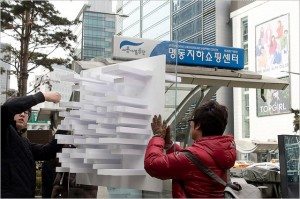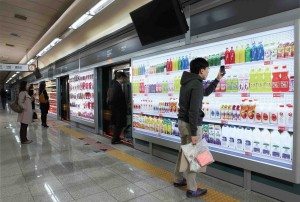As marketers, we often ponder whether we want to toy with those squarish, alien-looking symbols called QR codes. Some believe they are effective while others point out that less than 25% of college students even know how to scan them. Disillusioned consumers often brush the pixely images off as gimmicks that seem only to bring users to more advertising, but advertisers in South Korea have used QR codes to turn marketing on its head.
Using Shadows for Sales
Let’s start with a recent example. Earlier this year, Korean grocery chain Emart was experiencing slowdowns in business during the early afternoon hours. In order to boost activity during this time of day, Emart decided to promote a sale in order to attract customers during a normally calm period. Not content with simply printing flyers or placing ads in the newspapers, the retailer decided to make waves and turn heads with its efforts by constructing 3D QR code statues placed throughout the city of Seoul.
To form the scannable objects, the statues use sunlight to display the QR code – from the hours of noon to 1pm each day, sunlight cast over the statues form a shadow of the codes. The special offers and coupons earned by scanning these codes make up what the retailer calls the “Sunny Sale,” which can be redeemed via smartphone. Thanks to some bright thinking on the advertising side, Emart saw a membership increase of over 50 percent and a 25 percent increase in sales during the noon to 1 pm period. For a demonstration, check out this YouTube clip at around the 30 second mark.
Subway Shopping Spree
Emart isn’t the only grocery store in Korea to make memorable moves in marketing, however. In fact, its main competitor reached the number one spot in online sales due to its own unique use of QR codes.
According to this survey by the BBC, South Koreans work more hours than any other developed country in the world. In 2011, Korea’s Tesco grocery store used this information to create a store that would fit a busy Korean’s schedule perfectly: grocery shopping in subways. Now, before you gag at the thought of purchasing your groceries in one of the not-so-pleasant subway stations that you may be accustomed to here in the U.S., keep in mind that the shopping is done virtually, never mind the fact that Korea’s subway stations are clean as a whistle.
Banners displaying food were set up to cover the walls of the stations, with QR codes underneath each product. This imitates the action of actually walking up and down aisles to peruse food. When you find items you want to purchase, you simply scan the code and the product is added to your cart. When you check out, food is sent directly to your home without the need to ever visit a physical grocery store, and shopping is accomplished while waiting for your ride home.
Koreans loved this concept, and Tesco managed to move up to number one in online sales while maintaining second (though gaining) behind Emart in physical store sales.
QR codes receive a lot of flack for simply pointing consumers in the direction of Facebook pages, Twitter profiles, or even just more advertising, and for this reason, the public largely dismisses them. However, Korea has shown that it’s not the QR codes themselves that often fall short, but how they’re used that doesn’t spur interest in the public.
Can QR codes make a turnaround in the US market? Or will they remain as just another gimmick in the eyes of consumers?

